
Pigment Automations use Metrics to set conditions that trigger a task to defined Members. This article discusses how to set up a task in Automations.
This topic for Pigment Members who are task owners. A task owner is responsible for creating tasks, monitoring their status, performing actions on the tasks, such as updating assignees, sending reminders and so on. If you’ve been assigned a task and need more information on performing it, see Interact with Your Assigned Task.
Why not enroll in the Pigment Tasks course in the Academy?
Before you begin
- Permissions. You need the
Configure AutomationsPermission to be able to Create/Edit/Delete/Enable/Disable an Automation. This Permission has been granted to all Members having theConfigure BlocksPermission. You need theView HistoryPermission to view the execution details of each Automation.
- Notification settings. Each Pigment Member configures how they want to receive their notifications. This can’t be done by other Members as it a personal setting. See Pigment's Notification Center for more information on notifications.
- Define the triggering Metric. The first step in creating an automated notification is to define or create the Metric that triggers the Automation and then creates the notification. This Metric can be user input driven, such as a request for approval, or formula driven, for example writing a formula that is equal to true. We recommend that you select or create this Metric before you begin creating your new notification.
Set Up an Automated Task
Step 1. Create an Automation
- Navigate to the Application Settings.
- Click Automations from the Application sidebar.
- Click Create an Automation.
- Enter a Name and Description for the Automation. This information will be for the management of Automations and for others to understand the purpose of this Automation.
You can create an automation directly from any Metric or Table by right-clicking on a Metric name and selecting Set Automation on update.
Step 2. Establish a Trigger
- To set up the Trigger for your Automation, select the Metric that will trigger the action when the defined value is met based on the data type and its corresponding trigger operator as shown in the following table:
| Data Type | Trigger Operators |
| Number, Integer and Date |
|
| Text |
|
| Dimension |
|
| Boolean | Equals True or False |
- Apply Trigger conditions. You can apply multiple conditions by clicking on Add a condition.
Trigger conditions allow you to choose specific items within the dimensions of your Metric for a more targeted automation. First select the dimension from the Metric that you want to apply the condition to, then select the values from that dimension. For example, if the automation should only be triggered for a specific Country, select the Country dimension and then which country this trigger applied to.
- (Optional) If you have Scenarios configured for your Pigment application, select a scenario from the Trigger only on Scenario menu. This specifies in which Scenario your task is triggered.
- Click Create Tasks to assign a task to a Pigment Member.
Step 3. Select Assignees
When selecting assignees you can choose between the following:
- Direct. These receive a task every time the automation is triggered.
- Conditional. These only receive a task based on the items assigned to them from an associated Metric. For example, if you have a Triggering Metric that applies to all countries, you can set up a Metric for conditional assignees and select which Member receives a task for each country.
Depending on your selected Metric, the Conditional assignees configuration appears. You can click Set up Configuration to launch a wizard that creates all the necessary dimensions including the User list for your Conditional Assignee Metric. The User list will show all the Members in your application, next to the dimensions from your Triggering Metric. For each Member you want to receive a task, set the boolean to true for the associated items.
When choosing or creating a Metric, it must contain all or some of the dimensions used in the Triggering Metric, along with the User list. You can learn more about how to set up conditional assignees in Setting up Conditional Recipients and Assignees. - Both. This combines both types of assignees, this means you can associate some Members to certain conditions, and other Members will always receive a direct task.
When more than one assignee is selected to perform a task on a specified triggered item, two things occur:
- only one task is created when the triggering conditions are met for that item
- the task is then shared between the selected assignees
Also, when one of the selected assignees marks the task as Done, then the task is updated as Done for the remaining selected assignees.
Step 4. Enter Task Details
Enter a Task Title and specify the task instructions in the Task Description field.
You can use dynamic content when completing these fields. This content brings in details from the selected Metric’s Dimensions to your triggering event. For example, the date and time, and the item details of the Dimensions used in structure, as well as the value that triggered the task. These can all be used in the title or content of the task.
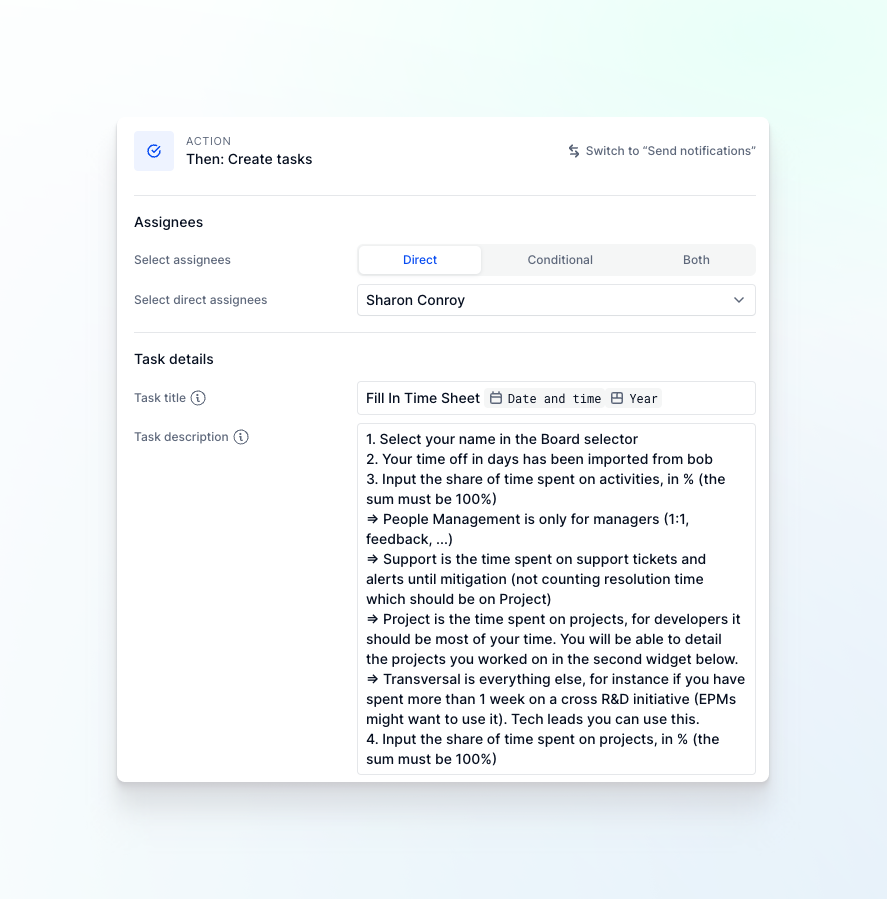
Click + Add dynamic content or use the cmd or ctrl + / shortcut to see a list of options that can be used. | 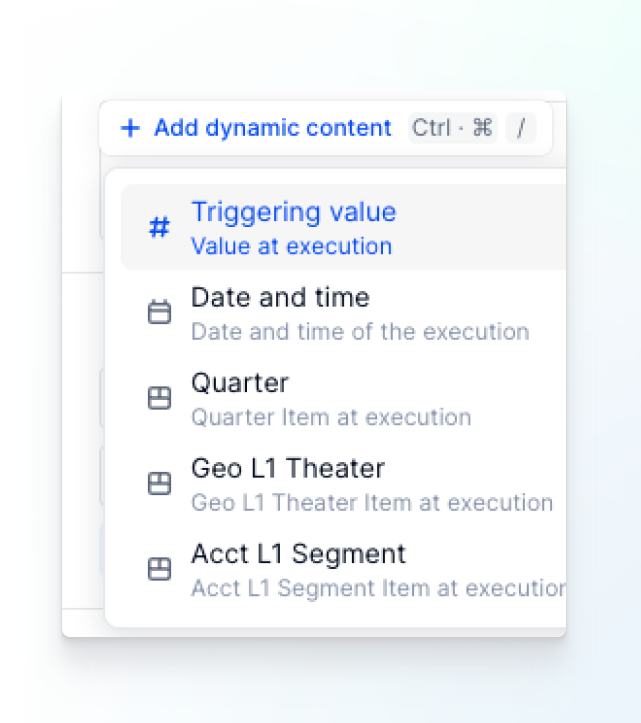
|
| Dynamic content | Value |
|---|---|
| Triggering Value | The value that was entered into the cell that triggered the task. For example, it could be a number, true or false, name of dimension item, or any other formatted entry. |
| Date and time | Shows the time and Date DAY, DATE, MON YYYY HH:MM:SS GMT |
| Dimension name | This option will appear as the name of the Dimensions used in the Triggering Metric. The number of dimensions used in the Triggering Metric will determine how many options are present. Selecting one of these will return the item from that dimension that triggered the task. For example, |
Step 5. Set a Due date
Select these options for the task due date:
- Due date. This can be a specific time, and a specific number of days, weeks, or months after the automation is triggered.
- Time zone. Select the time zone in which the due time and reminders are sent.
- Reminders. This can be a specific time, and a specific number of days, weeks, or months after the automation is triggered, or before the task due date. You can schedule up to three reminders.
The previous and next reminder to be sent can be viewed for each task in the Task management page. If a task is completed before a reminder is sent, then all reminders for that task are cancelled.
Step 6. Set up the Task redirection
Select where you want Members to land on when they click on the task.
- A Board: Select a Board to which Members are redirected. If Page Selectors are available for your selected Board, these are displayed. Some or all these options may be available for your listed Page Selectors:
- Same as Board: The user lands on the default Page options for this Board.
- Set Page Items: Use this option to assign the specific Page Selectors that you want to display on the user’s landing Board.
- Set from Trigger: Use this option to set the Dimension page selector to the item from the Dimension that triggered the Automation.
This is available only when the Dimension is also in the Automation's Triggering Metric's Dimensions.
- A specific Pigment link: Enter the link to the Board or widget that you want Members to land on when they click on the task. External links are not supported.
URLs from a Board or widgets are page selector specific. This means that when you copy a link, it also copies the current page selections.
Here’s how due dates and task redirections should look in your new task:
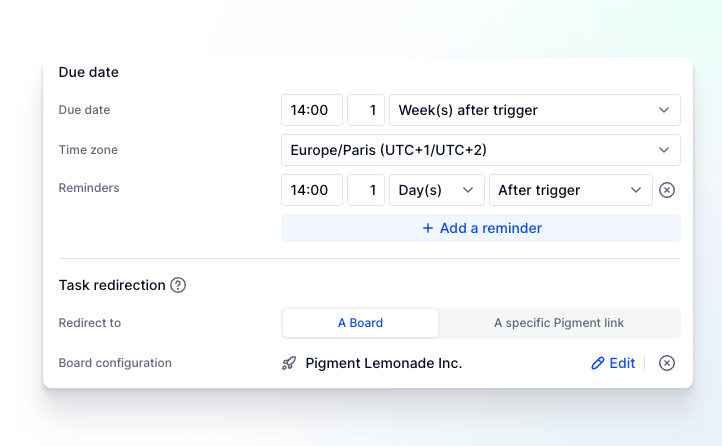
Step 7. Save and activate the task
Click Save at the top of the screen to save your new Automation. New Automations are not activated by default. Open the Settings page, and then Automations, use the toggle switch to activate the automation.
Administer the Application’s Tasks
Application Settings
In the Settings page, you can view the Automations available in your application. Here you can sort, filter, and search, as well as perform the following actions:
- Show or hide the Automation’s history
- View a summary of the Automation execution
- Edit the Automation
- Duplicate the Automation
- Change the Automation owner
- Delete the Automation

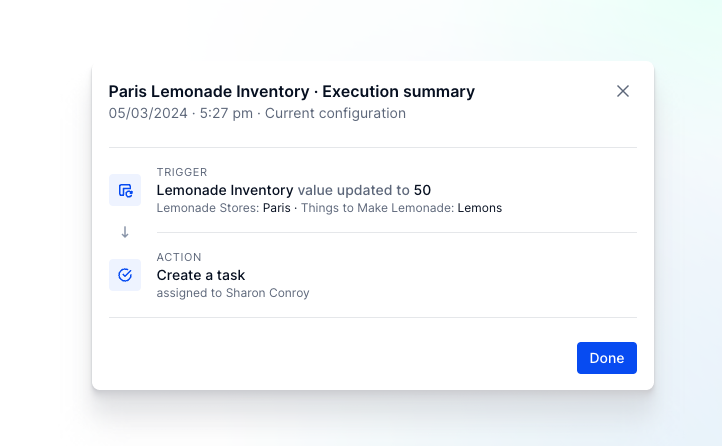
Task Management
Click Task management in your Pigment sidebar.
This displays all the automated tasks created for the application you’re working in.
Do one of the following to display a specific task or tasks:
- Locate the tasks you want to view filtering according to status, due date, and task name.
- Search all tasks by entering the task name in the Find a task field.
If you choose to display all the tasks in your application, an alert stating the number of any overdue tasks is displayed at the top of the screen. Click Review to display them.

When the list of required tasks is displayed, you can select a task and hover over the task name and due date for more details.
If a task is incomplete, you can use the menu (...) to perform any of these actions:
- Mark task as done. The task status changes to Done - simple! If there are other task assignees, then the task is marked as Done for everyone. The task disappears from everyone’s My Tasks list, but the task can be viewed in the list of Done tasks.
- Update assignees.
- If you remove an assignee and replace it with a new assignee, then the task disappears from the original assignee’s My Tasks list, and they no longer receive notifications. The new assignee receives the task, and the corresponding notification.
- If you add a new assignee to a task, then the new assignee receives the new task. The next reminder is sent to both the original and new assignee. - Send reminder. Resend a reminder to all assignees.
- Delete task. If a task is deleted, this disappears from the assignee’s My Tasks list and is no longer available.
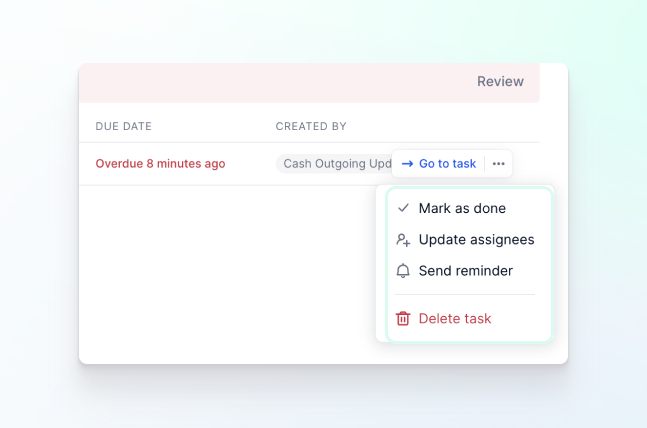
If a task is complete, you can use the menu (...) to perform any of these actions:
- Go to the task
- Delete task
More information on Automations
Automate your Pigment Applications
Set Up a Pigment Automated Notification
Setting up Conditional Recipients.



